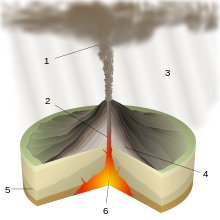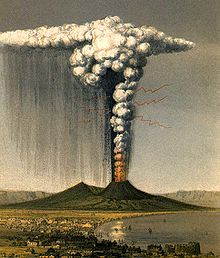

Plinian eruptions or Vesuvian eruptions are volcanic eruptions marked by their similarity to the eruption of Mount Vesuvius in 79 AD, which destroyed the ancient Roman cities of Herculaneum and Pompeii. The eruption was described in a letter[1] written by Pliny the Younger, after the death of his uncle Pliny the Elder.
Plinian/Vesuvian eruptions are marked by columns of volcanic debris and hot gases ejected high into the stratosphere, the second layer of Earth's atmosphere. The key characteristics are the ejection of a large amount of pumice and very powerful continuous gas-driven eruptions.
Short eruptions can end in less than a day, but longer events can continue for several days or months. The longer eruptions begin with production of clouds of volcanic ash, sometimes with pyroclastic surges. The amount of magma ejected can be so large that it depletes the magma chamber below, causing the top of the volcano to collapse, resulting in a caldera. Fine ash and pulverized pumice can be deposited over large areas. Plinian eruptions are often accompanied by loud sounds. The sudden discharge of electrical charges accumulated in the air around the ascending column of volcanic ashes also often causes lightning strikes, as depicted by the English geologist George Julius Poulett Scrope in his painting of 1822 or observed during 2022 Hunga Tonga–Hunga Ha'apai eruption and tsunami.[2]
The lava is usually dacitic or rhyolitic, rich in silica. Basaltic, low-silica lavas rarely produce Plinian eruptions unless specific conditions are met (low magma water content <2%, moderate temperature, and rapid crystallization);[3] a recent basaltic example is the 1886 eruption of Mount Tarawera on New Zealand's North Island.[4]
- ^ "Pliny Letter 6.16". Retrieved 22 November 2022.
- ^ "Hunga Tonga volcano triggered nearly 400,000 lightning strikes". 17 January 2022.
- ^ Bamber, Emily; Arzilli, Fabio (2020). "Pre- and syn-eruptive conditions of a basaltic Plinian eruption at Masaya Volcano, Nicaragua: The Masaya Triple Layer". Journal of Volcanology and Geothermal Research. 392 (15 February 2020): 106761. doi:10.1016/j.jvolgeores.2019.106761. hdl:11581/457982. S2CID 214320363.
- ^ "Okataina Volcanic Centre/ Mt Tarawera Volcano". GNS Science. Retrieved 15 January 2020.